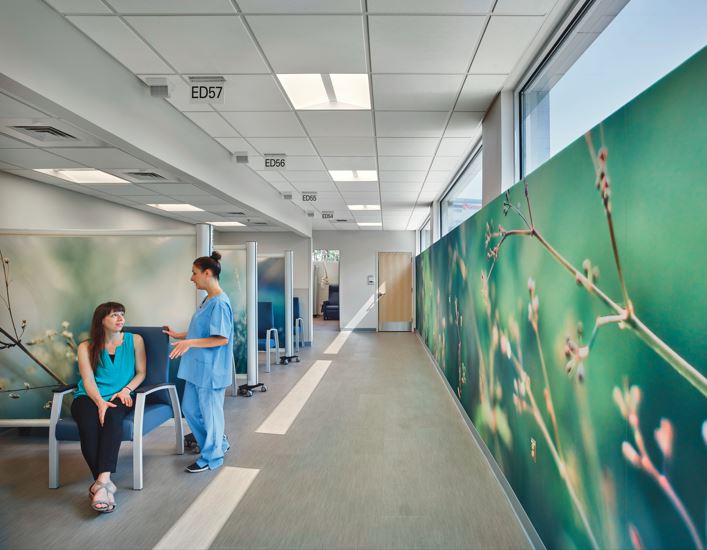
This article explores how, as a result of the COVID-19 pandemic and the increased focus on infection control, hospitals are moving away from traditional curtains in favour of modern screening solutions
One of the biggest challenges facing the health sector when the COVID-19 pandemic hit was controlling the spread of infection inside hospitals. And, with only a few acute hospitals having single bedrooms available in which to separate patients, the pressure was on to find innovative solutions. Traditionally, curtains have been used to divide patient bed spaces, with many modern disposable products routinely impregnated with antimicrobial properties to help limit the spread of infection. But, increasingly, partitions and screens are being favoured, primarily for their flexibility and ease of cleaning, a key consideration during the pandemic. Research carried out in 2020 by privacy screen manufacturer, nojerm, compared the advantages of hospital curtains and privacy screens.
Counting the cost
It found that the initial cost to purchase and install screens is about 1.5 times that of curtains, but that this investment is quickly repaid through significantly[1]lower operating costs. And an independent study calculated that, over a period of six years, screens cost 42.4% less than washable hospital curtains, and 31.1% less than disposable curtains. Space optimisation and flexibility also make screens a more-attractive option, as well as ease of cleaning. A spokesman for nojerm said: “Increased pressure on healthcare facilities has highlighted the importance of versatility and while curtains occupy little space when folded back, they are restricted to the fixed locations of curtain tracks. “Freestanding mobile screens can quickly and easily create additional assessment, treatment, and bed spaces in any location, yet be compactly stored offsite when not in use. “And, in terms of cleaning, while many hospital curtains are now treated with antimicrobial agents, this is moulded into the plastic of our CleanScreen privacy screen panels, for example, for longer-lasting efficacy.
Versatile and cost effective
“Privacy screens can also be cleaned in situ, while curtains have to be removed and taken away, which increases the risk of wider contamination. “While curtain track systems are still being installed in new-build and refurbishment hospital projects, the evidence falls clearly in favour of medical privacy screens as the most[1]cost-effective, versatile, low[1]maintenance, and hygienic option.” And it seems hospital purchasers are increasingly recognising this. During the pandemic, KwickScreen saw sales of its mobile screens increase by 151% as hospitals looked to create additional flexibility on the wards, with the company named the 12th-fastest growing private firm in the UK in the FEBE growth 100 for 2022. Alan Murrell, chief executive, said: “The pandemic highlighted the need for flexibility in hospital spaces to allow for the ability to rapidly adapt and respond to situations as soon as they arise. “Our mobile KwickScreens are not limited to tracks, so can generate spaces of any size, anywhere in the hospital. “For example, they can be used to provide patients with privacy and dignity when they are stationed in areas impossible for curtains to be used, for example in corridors. “With a single touchpoint, they have been designed with a non-porous surface and minimal dirt traps, meaning they are easy and quick to clean with standard hospital products. This reduces the resistance to regular cleaning that is sadly often seen with curtains.” As well as helping to divide spaces and reduce the spread of infection, modern screens can also be printed onto with graphics or colours, helping to enhance the overall environment for patients, visitors and staff.
The power of art
Murrell said: “While hospitals have become increasingly cutting edge, they remain a sterile environment that can, at times, be quite intimidating and stressful to patients. “A simple remedy is to harness the power of art at the bedside. “Art has repeatedly proven to reduce stress, anxiety, depression, and pain in both patients and healthcare staff, thus improving clinical outcomes. “Different colours affect our emotions differently. For example, blue is a calming colour while green, a signal to nature, can invoke the feeling of peace. “Different graphics can also be printed onto the screens for specific areas or uses. “Child-friendly art that can be coloured in would be perfect for making a more-dynamic paediatric department, for example. “Additionally, images of nature such as botanical gardens and forests, provide an ‘escape’ from the stressful environment of a hospital.”
Making a decision
When specifying screening solutions, Murrell advises a four-pronged approach considering hygiene, flexibility, sustainability, and purpose/location. He said: “Purchasers must consider that the future of hospitals must be flexible and choose products which will allow for this. “And, with healthcare associated infections prevalent in hospitals across the world, choosing a product which improves infection control will allow hospitals to save lives and money.” The focus on sustainability is also key as the Government recently mandated that all NHS suppliers must publish green plans outlining their commitment to reducing their carbon footprint. Murrell said: “Healthcare contributes to almost 5% of global greenhouse gas emissions. Therefore, there is a huge movement towards the procurement of more-sustainable products in healthcare and this must be considered when sourcing products as often disposable and washable fabric curtains can be detrimental to the environment compared to long-lasting screens.” Their intended location will also determine which type of product is selected.
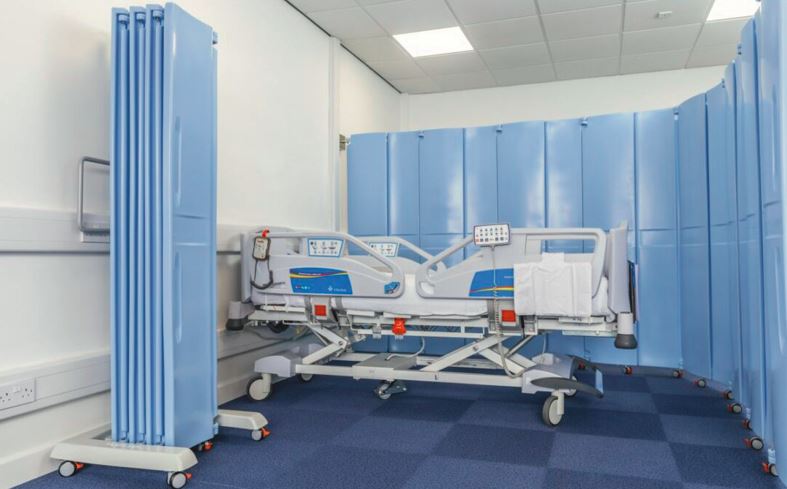
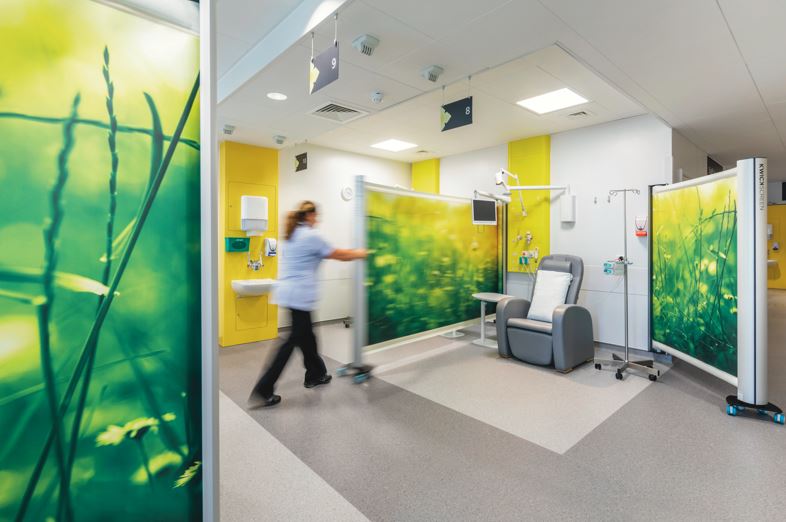
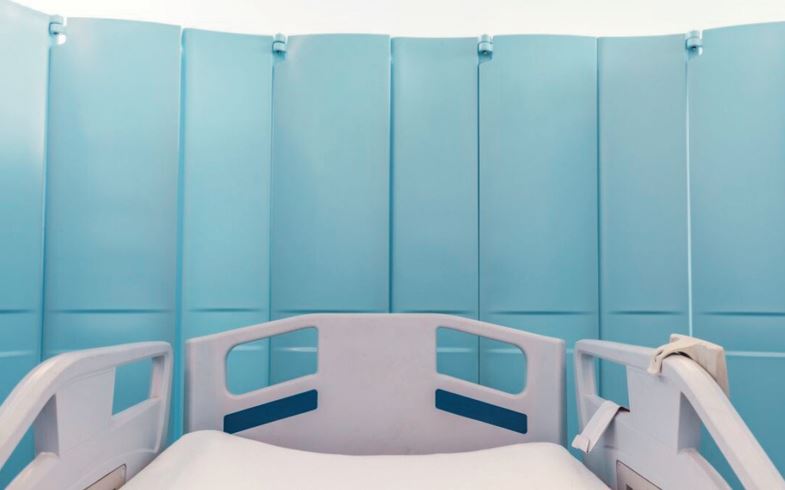
Fit for purpose
Murrell advises: “Products must be fit for purpose. “If you want a privacy partition between beds in a ward space, curtains and screens will fit this purpose. “However, screens provide a more[1]hygienic and sustainable solution while also providing hospitals with that extra level of flexibility in patient space generation.” Having seen sales increase during the pandemic, KwickScreen’s developers and designers are now focusing on the next generation of screening solutions. Murrell said: “Our new products include WindowSwitch, a switchable film that can be retrofitted to current glass to allow for the transitioning from a transparent to opaque window at the flick of a switch. “We are also currently trialling PatientRoom in some NHS hospitals, a revolutionary around-the-bed screen solution to using less-hygienic and less[1]sustainable curtains.”
Meeting the challenge
He adds: “The pandemic has highlighted the importance of hygiene. “Every patient should go into a clean space, but as we know this is often not the case where curtains are not changed. “We expect new technologies that continue to eliminate disposable fabrics to be key in the coming years and our R&D will continue to focus on innovating flexible, sustainable, and hygienic solutions to make healthcare environments better.” Greg Sunderland, owner of shading solutions company, Tritonpeak, had been supplying shading products to hospitals for several years. But, as soon as the pandemic hit, he was set a new challenge by Andy Munro of Three6T Architecture, who was working at the Countess of Chester Hospital and was looking for a retractable screen that could be used to divide bed spaces. The resulting Tritonshield, now in its second interation, has been designed and developed following feedback from clinicians, patients, and hospital infection control specialists. Unlike existing products, which utilise rollers; the partition does not take up valuable floor space and is instead attached to the ceiling in a similar way to traditional curtain tracks.
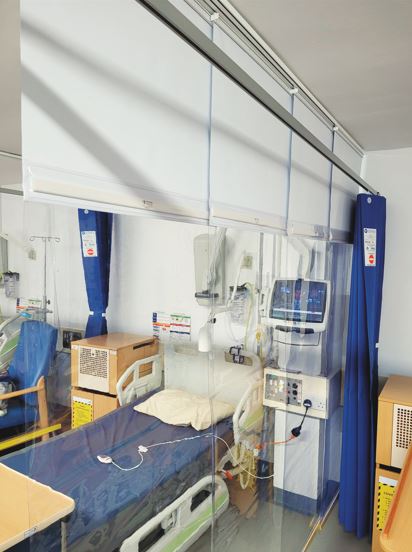
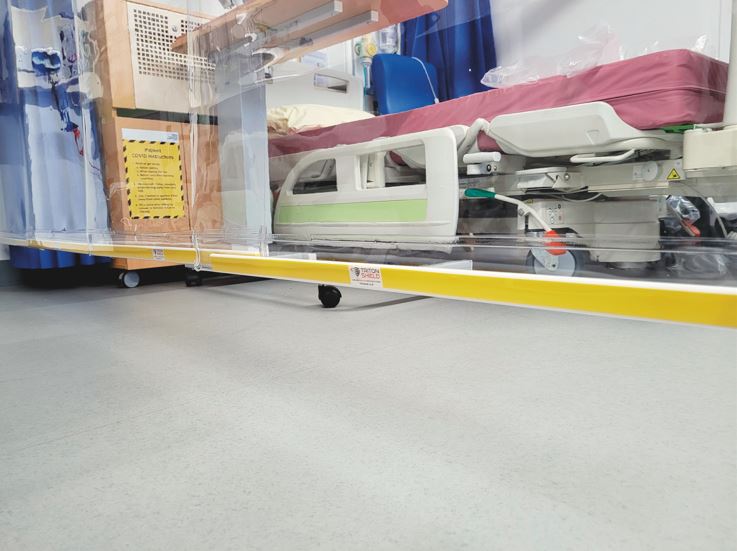
Maximum protection
A standard screen has four two-tone panels, clear up to 1.85m for patient visibility and with a solid-colour, non stick fabric at the top. The panels extend to 2.4m between the beds and can then retract back in the four-channel headrail, leaving the bay clear when not required. And this specification can be easily modified to meet most requirements. Sunderland said: “COVID-19 highlighted the need for screening between hospital beds in open wards, as well as in waiting areas. “There was not really an off-the-shelf solution, and we were asked to develop a product for bed segregation where space was tight. “The Tritonshield screens can be extended to the full length of the bed and create a ceiling-to-floor barrier to prevent large airborne particulates. “And it is ceiling mounted alongside existing privacy curtains, so offers the full flexibility of both privacy and pathogen protection." He added: “As a relatively-new feature on the ward, bed segregation screens will need to become an integral part of ward design, in the same way, for example, that seatbelts and airbags were introduced to vehicles to meet legal requirements for safety. “In terms of design, we are continuously looking to improve individual components and create bespoke items where needed. “We have found that simplicity of design is usually the best policy for ease of use and robustness. “Screens need to be integrated into the initial design of new and refurbished wards, so they integrate seamlessly into the working environment for maximum protection with minimal intrusion.”